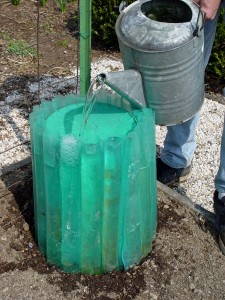The Year’s First Dead Plants
March 29th, 2011
Do I win a prize for the first killed plants of the season?
I’d like to nominate the green mush shown at right – what was to be my 2011 collection of pre-July ripe tomatoes.
Every year, I start a few tomatoes inside from seed around the end of January so I’ll have transplantable-size seedlings to go outside under Wall ‘o Water plant protectors each April 1.
I’ve been doing this for 25 years and have never lost a single tomato. I always go with cherry tomatoes and early-ripening varieties so I have actual good-tasting fresh, ripe tomatoes as early as humanly possible here in central Pa. – usually by the end of June.
Unless I can get my hands on some super-early greenhouse-grown substitutes, that isn’t going to happen this year.
Chalk it up to aging or trying to cram too many things into too little time (probably both), but my little band of eight baby tomatoes met a cruel frozen fate Sunday night.
I thought I’d give the flock a little sun and harden them off a bit for just an hour or so Sunday afternoon while I was planting some seed potatoes.
All of you similarly aging gardeners know exactly what happened next.
That’s right. I got distracted cutting a mum here, pulling a weed there, and before you know it, I was running late. I packed up, hustled inside and totally forgot about the tomatoes sitting on the patio table.
Monday morning, the poor ‘Early Girls,’ ‘Sweeties’ and ‘Manitobas’ were frozen stiff like skinny green popsicles.
I brought them inside hoping for a miracle but ended up with that familiar mush that I usually don’t see on tomatoes until late October.
They’re goners. I feel like a very reckless parent.
My main crop is already under lights, but they’re tiny and timed to be ready at the usual unprotected planting time, which is around Mother’s Day.
I even had three Wall ‘o Waters already set up – their water-filled chambers absorbing the sunlight and warming the soil inside. These things are some of my favorite gardening gizmos, and they really do a great job at protecting plants that otherwise would freeze.
The only catch is that you actually have to plant the plants inside of them. Do’h!









